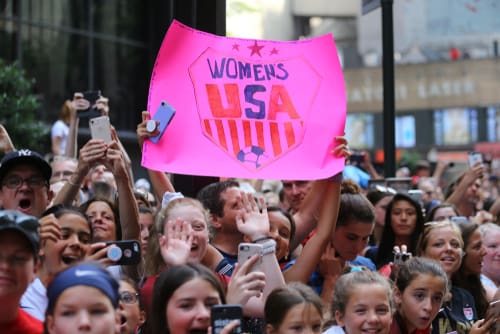All the press are celebrating the agreement by The United States Soccer Federation to align the Women’s and Men’s Soccer teams’ pay and distribution of prize monies. It is time, isn’t it?
The Federation has reached landmark collective-bargaining agreements with its men’s and women’s national teams. The terms create pay parity, aligning the men’s and women’s teams’ pay and creating a unique mechanism to share the prize money coming from their respective World Cup competitions. This deal recognizes that regardless of sex, people are people, and they should be paid for performance, not for gender.
Why was this Equal Pay for Equal Work So Challenging?
For most of our history, businesses have embraced pay inequities. Going back to the 1860s in the U.S., women have tried to pass legislation to establish a firm foundation for pay parity with gender and racial equity. Congress did not take action until 1963 with the passage of the Equal Pay Act. Some corporations and businesses have realized that with women representing over 50% of the workforce, it is time to rectify gender bias in pay, position, and power.
Many systemic and cultural reasons are at the root of this history of lower wages for some people based on their gender, race, or other biases, such as the devaluation of women’s work or claims that women have family care considerations. Slowly, very slowly, these are changing.
The U.S. Women’s Soccer team’s successful negotiations with the Men’s Soccer team are impressive. It took six years of hard work and a mutual agreement between the men and women to share their prize money.
I love the quote by Walker Zimmerman, a defender on the men’s team and a member of the union’s leadership group. As he said, persuading the rest of his teammates to share the money involved “difficult conversations, a lot of listening, a lot of learning.”
The most interesting angle is how they had to convince men to part with prize money. The amounts are significant. For 2019, the 24 teams at the Women’s World Cup competed for $30 million in prize money. In contrast, the 32 men’s teams competing in November 2022 will split $450 million.
“They were true champions of this,” Cindy Cone said of the men’s team’s embrace of equalizing pay more broadly and prize money specifically. “It’s not easy to give up the money they’re giving up. To know it’s the right thing to do, and then to step up and do it, I think they should be applauded.”
What Are Companies Doing Today?
How can this decision become a benchmark for businesses and athletic organizations, so they commit to equal pay for equal work? You can read about those companies that have adopted the Equal Pay Pledge. The list is growing.
At the Rethinking and Accelerating Diversity and Women in Business Forum on May 11, 2022, over 1000 men and women came together to hear from leaders in those major corporations committed to pay parity, along with gender and racial equality. One of my favorites of the panelists, Maria Colacurcio, the CEO of Syndio, has developed software to help companies evaluate their actions, not just their verbal PR commitment. And Johanna Zeilstra’s company, Genderfair.com, is evaluating corporations on how fair they are to gender and racial diversity, allowing consumers to buy from those who are moving women forward.
Each of Our Actions Are What Matter the Most
At Simon Associates, we have been particularly sensitive to women’s issues and treating everyone on an equal playing field. A large part of our agenda is in support of women. We have developed a program entitled Rethinking Your Journey with Andi Simon. This is a self-directed program that allows professional women to focus on their strengths, what they like to do and what they don’t want to do and redirect their careers.
Our CEO, Andi Simon, has been in a leadership position at the Women Business Collaborative. The WBC’s initiatives focus on getting more women on corporate boards, more women into C-suite positions with P & L responsibility, equal pay for equal work, better access to capital for women entrepreneurs, expanding women in STEM, and making DE&I happen. Andi also speaks widely on this subject and recently was the keynote speaker for MLive’s Women’s Summit in Michigan.
SAMC has numerous blogs and podcasts on women succeeding in what was traditionally a “man’s world.” On January 18, 2022, our blog entitled “Two Incredible Women Who Are Succeeding in A Man’s World” highlighted trailblazing women. One of them, Christine Grant, became the first female athletic director in 1973 (although there were two, one for males and one for females). If you haven’t read the blog, you can read about it here: “Two Incredible Women Who Are Succeeding in a Man’s World.”
In another blog, we wrote about women shattering stereotypes: Women “Firsts” Shatter Stereotypes, Look Forward, focused on leadership and coaching positions for women in the NFL. One of our readers’ favorites is a story entitled “It’s a New Day!!! Finally, Women Have a Seat at the Table. ” This blog talks about women becoming officials in men’s sports.
So, with the history of women moving forward slowly, it is encouraging that these female soccer players have reached a landmark decision that allows them to receive the same rewards for the same job on the soccer field.
Are You Trying to Build that Organization that Lives DE&I? Perhaps we can help?
At Simon Associates, we are helping to re-craft what women can do in our society. Our work is purposeful to help other women have role models, support women as mentors as they venture into their businesses or corporate positions, encourage women to achieve c-suite positions, and help create companies with purpose.
Together we can do better. Let’s collaborate to build businesses and organizations that believe in and live diversity, equity, and inclusion.
To learn more about our approach to building better organizations, contact us.
From Observation to Innovation,

Andy Simon
Partner, Simon Associates Management Consultants
Info@simonassociates.net



